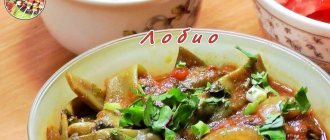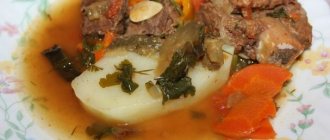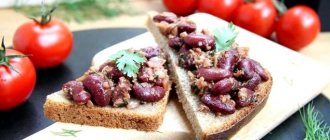7
Prepared by: Vladimir Bratikov
11/21/2016 Cooking time: 1 hour 30 minutes
| Save | I cooked) | Estimate |
This is a tasty, easy to prepare and very popular Georgian cold appetizer. Essentially, it is a vegetable pate with aromatic spices and herbs. Prepared both on weekdays and on holidays.
From the history of the dish
It is Caucasian cuisine that is rich in an abundance of snacks. They are often made from fresh seasonal vegetables, and a large amount of herbs will definitely be added, since herbs are the basis of Caucasian cuisine and its recipes. The favorite vegetable snack in the Caucasus is pkhali . This noun has already become a common noun, since pkhali means a special type of preparation of vegetables. The base of the dish, vegetables, will definitely be served with a spicy walnut sauce - an important component in a cold appetizer .
Initially, the recipe involved using only cabbage, but by experimenting with different vegetables, other variations of the snack were created . The favorite option in Georgia now is green. It reminds of the arrival of warmth, as it is made from fresh herbs and young beans in early spring. Pkhali can be red, purple, or white. In Russia, this dish spread thanks to Russian officers. Russian soldiers in Tiflis admired the pleasant mixture of flavors of vegetables and spices. However, they did not like the name invented by the Georgians at all, which is why this cold appetizer was nicknamed mkhali in the nineteenth century. Even now in Georgian restaurants the dish on the menu remains under this name.
Cooking secrets
Many modern recipes recommend using a blender to grind beans; in practice, this should not be done, since it is difficult to grind small portions of food with a blender . Therefore, dense ingredients such as garlic and walnut kernels will have to be crushed along with the beans.
Finely grinding dense ingredients into a large volume of puree is quite a difficult task; you will have to increase the operating time of the blender. At the same time, moisture is knocked out of the boiled products and the mass begins to “flow,” which is unacceptable for pkhali. It is optimal to use a meat grinder with a fine grid, and ideally a manual one .
Since the finished treat looks rather modest, it is customary to decorate it with colorful additions. The most popular of them are scarlet seeds of ripe pomegranate, they are used to sprinkle pate. If vinegar is replaced with lemon in the recipe, then it is logical to supplement the portions of pkhali with citrus slices.
A colorful design that will suit any of the recipes described below can easily be created from large bell peppers and eggplants. The vegetables are washed, the eggplants are cut into longitudinal strips up to 2/3 of the dark skin, and the peppers are cleaned of seeds.
The fruits are cut into circles, after which the eggplants are salted and the bitter juice is allowed to drain. After washing the vegetables, place them separately in oiled roasting pans, no more than 1 layer . Bake the peppers for up to 15 minutes, and the eggplants, depending on the thickness of the circles, but no longer than 25 minutes.
The prepared vegetables are allowed to cool and placed on slices of bread, a spoonful of pkhali is placed in the middle of the pepper rings, and the pate is placed in a small mound on the eggplants. Another decoration component can be young zucchini; the center with the seeds is cut out before baking.
Traditional recipe
You will need:
- 500 g green beans;
- 20 ml lemon juice;
- 5 sprigs of cilantro;
- ¼ pod of hot green pepper;
- 140 grams of nuts (walnuts);
- hops-suneli to taste;
- 3 cloves of garlic;
- pomegranate seeds;
- add salt to taste.
Cooking: 35 minutes.
One serving: 205 kcal.
Preparation:
- Boil the green beans for 7 minutes over low heat; at the end of cooking, drain the water and cool the vegetable.
- Grind the nuts in a meat grinder using a fine grid. Grind the garlic, passing it through a press, grind the cilantro in a blender bowl. Combine all prepared products, pour in lemon juice and mix thoroughly.
- Place the middle rack on the meat grinder and pass the beans through it. Add nut mass and suneli hops to the vegetable puree.
- Form small round cutlets from the prepared mixture. Serve on a beautiful plate.
Sometimes pkhali is served as a pate, placed in a bowl.
Step-by-step recipes for making pkhali (with photos)
With spinach
Along with the same cabbage that gave the name to the whole dish, spinach and beet tops are considered the traditional basis for pkhali. Would you like to start your introduction to Georgian cuisine with a real classic? Then you will need the following ingredients:
- 400–500 g of fresh spinach or 1 package of frozen spinach;
- a bunch of parsley;
- a bunch of dill;
- a few feathers of green onions;
- 100 g peeled walnut kernels;
- 1–2 cloves of garlic;
- a quarter of hot green pepper or a pinch of ground chili;
- 2/3 tsp. hops-suneli (you can add any other seasonings to taste);
- pomegranate seeds for decoration;
- salt.
Preparation:
- If you use frozen greens, be sure to defrost them first.
Frozen greens must be removed from the refrigerator in advance. - Cook the spinach in a frying pan with a few tablespoons of water until it becomes soft.
Five minutes is enough to bring the greens to readiness. - Let the “semi-finished product” cool and squeeze it thoroughly to remove excess moisture, and then pass it through a meat grinder or blender.
The mixture should not be too liquid - Chop the nuts.
The finer the closer to the original recipe. - Finely chop the dill, parsley and green onions.
Tarragon, basil, cilantro - you can choose greens at your own discretion - Peel the garlic and pass through a press or finely chop.
In the old days, housewives did not know about a garlic press - Combine ground spinach, herbs, nuts, garlic, spices.
Add salt and mix thoroughly. Form balls from the resulting mass. Let the portions not be too large - they are more convenient to manage at the table - Place on a flat plate and garnish with pomegranate seeds and parsley.
This treat has a place on the holiday table!
With beet tops
You will need:
- 500 g tops;
- 100 g cilantro;
- 100–150 g peeled walnuts;
- a voluminous pinch of hops-suneli;
- 1/3 tsp. red hot pepper;
- a couple of cloves of garlic;
- pomegranate seeds;
- salt.
Preparation:
It will be easier to make balls with your hands dipped in water.
With green beans
You will need:
- 500 g green beans, fresh or frozen;
- one large bunch of cilantro and parsley;
- 150 g peeled walnut kernels;
- small onion;
- 1/4 part hot green pepper;
- a pinch of hops-suneli;
- garlic clove;
- pomegranate seeds;
- salt.
Preparation:
With round beans
You will need:
- 500 g beans;
- a bunch of cilantro;
- 200 g peeled walnut kernels;
- 2–3 cloves of garlic;
- 1/2 tsp each ground coriander and suneli hops;
- a pinch of hot pepper;
- 1.5–2 tbsp. l. wine vinegar;
- salt.
Preparation:
Pkhali can be stored in the refrigerator for a long time without any harm to the taste and benefits, so no one bothers you to prepare it for future use.
From white cabbage
You will need:
- 600 g cabbage;
- one large onion or a couple of small ones;
- a large bunch of cilantro;
- 100 g peeled walnut kernels;
- 1–2 cloves of garlic;
- spices: suneli hops, ground coriander, hot red pepper;
- pomegranate seeds;
- salt.
Preparation:
To make the dish more tender, remove the tough part at the base of the cabbage leaves.
From eggplant
You will need:
- 2–3 medium sized eggplants;
- a bunch of cilantro;
- 100 g walnut kernels;
- 3 cloves of garlic;
- 1/2 tsp. ground coriander;
- pomegranate seeds;
- a couple of tablespoons of vegetable oil;
- salt.
Preparation:
From the restaurant chef
Ingredients:
- 0.5 kg green beans;
- 75-80 g onions;
- 3-4 sprigs of cilantro and parsley;
- ¼ part of a green hot pepper pod;
- 145 grams of walnuts;
- add suneli hops to taste;
- a clove of garlic;
- pomegranate seeds at your discretion;
- 6 grams of fine salt.
Required: 25-35 minutes.
Serving: 203 kcal.
Step by step cooking method:
- Boil the beans for half an hour over low heat, then drain the water and cool the vegetable.
- Add onions, garlic, nuts, herbs, hot peppers to the beans, grind everything in a meat grinder, mix, season with spices to taste.
- From the smooth bean mass, form into products of the desired shape (balls, balls, pyramids). Place on a plate and garnish with pomegranate seeds.
Manufacturing process
- If you took frozen beans, prepare them: first put them in a warm place for half an hour.
- Remove all excess beans (leave the pods), wash, boil in salted water for ten minutes without stirring. This way it won't be too soft.
- After this, keep it in cold water, allowing it to cool.
- Squeeze with your hands and grind in any convenient way (meat grinder, blender). However, the first method of grinding slightly spoils the final taste of the snack.
- Peel the onion and chop into cubes. Scald with boiling water.
- Finely chop the garlic, cilantro and nuts of your choice. You can use a stupa.
- Mix nuts, onions, beans. Salt and add other spices to taste. You can first fry the coriander in a dry frying pan, stirring constantly.
Tip: the mass will become more elastic if you mix it with your hands rather than with a spoon.
- Form portions into cutlets or flatbreads. Leave in the refrigerator for 45 minutes.
- Garnish the bean dish with remaining herbs, pomegranate seeds, or your favorite berries. You can use a knife to draw unusual patterns, put edible decorations in them, and then serve them to the table. The bean dish is ready. In the photo you can see the serving option.
Tip: you don’t need to add spices to the bean mince except salt. In this case, prepare a nut sauce, to which add all the other spices. This way, your dish will not lose most of its vitamins and will not be spoiled if it is over-salted.
From red
Ingredients:
- Red beans – 300 g
- Walnut kernels – 100 g
- Ground paprika – 1 tsp.
- Garlic – 2 cloves
- Cilantro – 6 g (0.25 bunch)
- Khmeli-suneli – 0.25 tsp.
- Ground black pepper – 2 pinches
- Salt – 3-4 pinches
- Lemon juice – 0.5 tsp.
- Vegetable oil – 2 tbsp.
Preparation:
- Take the necessary ingredients to prepare Georgian bean pkhali (with walnuts).
- Soak the beans in water for at least 2 hours, maximum overnight. Then place the legumes in a cauldron or pan with a non-stick bottom, pour boiling water and place on the stove, boil for 1.5-2 hours. Monitor the liquid level in the container and add boiling water if necessary.
- Pour the boiled beans into the container of a blender or chopper. Add walnut kernels.
- Wash the cilantro, chop or replace it with chopped coriander. Add to the beans along with spices and herbs, salt.
- Pour in lemon juice and vegetable oil, chop, adding a little filtered water or the broth left over from the beans. Make sure that the mass does not turn out liquid.
- Wet your palms in water and form small balls, boats, etc. from the bean mass. – any shape you want. Place on a plate.
- Garnish with pomegranate seeds, red currants or any other.
- Georgian bean pkhali (with walnuts) is ready. Serve them chilled, garnished with fresh herbs.
Food selection and calorie content
The type of bean is usually indicated in the recipe, although it can be matched to beans already purchased. It is impossible to say that a specific type of bean makes a tastier snack; here we focus on personal preferences. The only note about the choice is that most often they use large beans; small beans leave a lot of rough skin after boiling.
Georgian bean pkhali is prepared without oil or other fats, and recipes with meat fillings are beyond the scope of the article. The calorie content of a dish is mainly determined by its main ingredient, beans, and to a lesser extent the addition of nuts. Among the varieties of beans, only black beans are somewhat different, containing half as much of any of the main nutrients.
You can compare different varieties using the data in the table; they are given per 100 g of dry beans, the only exception is green beans, which are used fresh or frozen.
The data is as follows:
| Bean variety | Calorie content | Carbohydrates | Fats | Squirrels |
| White | 323 | 63,8 | 1,81 | 20,96 |
| Red | 310 | 52,7 | 1,61 | 21,0 |
| Capsicum | 24 | 3,6 | 0,22 | 2,01 |
| Black | 132 | 23,71 | 0,51 | 8,88 |
Quality beans are determined by the equal size of individual beans and the minimum presence of debris and debris among them. The sorting is mainly reduced to removing specks; broken beans in the pate are invisible. Like many products, beans are cheaper when sold in bulk and offer the opportunity to inspect them before purchasing.
Carefully examine a handful or several grains, checking for small holes. These are traces of insect pests; such beans cannot be used for pates.
From green
Ingredients:
- Green beans – 300 grams (fresh or frozen)
- Onion – 1 piece (small)
- Walnuts - 1/2 Cup
- Garlic - 2-3 cloves (to taste)
- Green cilantro – 1 bunch
- Wine vinegar - 1 tbsp. spoon
- Salt - 0.5 teaspoons (to taste)
- Khmeli-suneli - 1 teaspoon (to taste)
- Ground red hot pepper - 1 pinch (to taste)
Preparation:
Boil the beans in lightly salted water for about 10 minutes. Then transfer the pods to a bowl of ice water for a few minutes. Squeeze the cooled beans and pass them through a meat grinder or grind them with a blender. Chop the onions and cilantro very, very finely. Grind the nuts in a blender and add them to the bean mixture. We also send chopped greens and onions there. Add chopped garlic, vinegar and all other spices. Mix until smooth. From the resulting mass you can make cutlets or balls. And serve, garnished with pomegranate seeds, nuts and herbs. Or lay it out and decorate it beautifully in a salad bowl. Place in the refrigerator for at least an hour and then serve.
Pkhali: a mouth-watering classic of Georgian cuisine
The word “phali” itself did not initially refer to ready-made food. It denoted the very same cabbage from which housewives prepared a delicious snack many years ago, when the traditions of Caucasian cuisine were just beginning to take shape. Why, many years ago! Even today there are connoisseurs who assure: real pkhali can only be made from pkhali cabbage and nothing else.
Fortunately, most foodies are not so harsh. Today, one of the most popular dishes of Georgian cuisine is prepared from almost all known types of greens: spinach, asparagus, herbs, beet tops, radish leaves, nettles, chard... Regular cabbage, cauliflower, broccoli, beets, eggplants are also used. mushrooms, beans, and in some places even rice, meat, poultry, fish and offal!
A delicacy for every taste and color (in every sense)
However, meat and fish are already trends of the new time. The classic version of the dish always remains strictly vegetable, moreover, prepared in full accordance with the once and for all established recipe.
- Traditional pkhali consists of two parts. The first, main one, is made up of leafy greens; second, additional - sauce with aromatic herbs and spices. Its composition may vary depending on the preferences of the cook, but walnuts, suneli hops, garlic and hot pepper remain almost unchanged components. The aromatic herb cilantro is no less common in recipes.
- There can be only one main ingredient of pkhali.
Mixing, for example, chard with beets, and nettles with spinach is considered unacceptable. It’s better to create two or three different snack options, each with its own type of greens. - A few more words about greenery. Firstly, in most cases it is subjected to heat treatment: stewed, boiled, blanched. Please note that the shorter the contact between the tops and boiling water, the better. This will preserve both taste and vitamins. Secondly, the greens will have to be thoroughly chopped (in the old days this was done with a sharp knife, but now a meat grinder and a blender are used) and squeezed to remove excess juice. Pkhali that spreads across the plate like a liquid mush is no longer pkhali.
- You will also have to grind the nuts: they should be turned through a meat grinder at least twice. Your snack should have a noticeable nutty flavor, but without any hint of pieces of kernels crunching on your teeth.
- The finished dish is a juicy, but dense and homogeneous paste, which is formed into neat balls or placed in a heap in a salad bowl, decorated with herbs, pomegranate seeds and onion rings. Less commonly, pkhali is spread on a leaf of blanched greens, rolled into a roll and cut into thin slices, or the paste is offered to guests in the form of a thick flat cake, on the surface of which diamond-shaped patterns are applied with a sharp knife.
The dish is served slightly chilled, so immediately after cooking it is worth putting it in the refrigerator for at least 20 minutes. Pkhali can serve as both a separate appetizer and an excellent side dish for the main dish.
Photo gallery: Popular ingredients for a classic snack
It never hurts to add some spice to a vegetable dish
Use your favorite seasonings, not just suneli hops
But without this ingredient, real pkhali will not work
The fragrant herb will add an appetizing taste and aroma to the dish.
Wine vinegar is one of the most popular dressings for pkhali.
The main component of the snack is greens
From white
Pkhali is not a specific dish, but a method of preparation . It is important to understand the principle of cooking and choose the exact proportions.
Ingredients:
- 230 g white beans;
- 8 sprigs of cilantro;
- 130-140 g walnuts;
- add hot green pepper to taste;
- 1 large clove of garlic;
- add salt to your taste.
Cooking: 30 minutes.
Serving value: 204 kcal.
Preparation:
- Soak the beans for several hours. Then rinse, add clean water and cook until fully cooked, then drain the vegetable in a colander and cool. Don't forget that salt is added at the very end of cooking.
- Make bean puree by passing it through the grill of a meat grinder. Do the same with the rest of the products.
- Combine all products together, mix thoroughly, season with salt.
- Form small balls or cakes from this mass.
Note : the cold appetizer can be served separately, or spread on a slice of bread.
Serving options
Instead of balls, you can put the mass into bowls. Decorate with the same berries, herbs or pomegranate. The result is a low-fat pate that can be spread on flatbread or bread.
For the holiday, you can make several types of this bean snack at once and place them on one large plate, forming an assortment.
Pkhali can also serve as a filling for pies or khinkali.
From the round
Beans of this variety are usually small and have a beige tint . Their taste differs slightly from other beans, but in spicy or too spicy dishes of Caucasian cuisine this may not be noticeable. In addition to round beans, so-called marble beans are often prepared with the addition of carrots.
It has the usual shape, but differs in color; it is soaked, changing the water, as for most dishes made from colored beans.
Ingredients:
- dry round beans – 250 g;
- a pair of garlic cloves;
- a glass of chopped nuts;
- sugar;
- a pinch of suneli hops and pepper;
- large sweet carrot;
- salt;
- cilantro - a small bunch.
How to cook:
- Soaking beans usually takes up to half a day, but in the case of round beans, 8 hours is enough. The water is replaced twice, but it is permissible to do this only before boiling.
- Beans are not placed in boiling water, except for cooking soups. After heating it together with water in a saucepan or kettle, lower the temperature to a barely noticeable boil and cover with a lid.
- It is not advisable to salt the water; readiness is checked by individual beans. As soon as the translucent film-skin begins to separate from them, pour the broth along with the beans into a colander.
- Boil carrots separately. For the sake of bright color and lack of taste, it is worth washing the root vegetable and not peeling it, but adding a little sugar to the water. Cool the carrots in a draft along with the beans.
- The garlic is peeled, coarsely chopped, and ground together with nut kernels, carrots and beans using a manual meat grinder. The cilantro is chopped by removing the leaves from the branches, salt and spices are added and the pkhali is thoroughly kneaded.
Carrots, when properly chopped, are not too noticeable in the finished pate, but bean pkhali with them turns out more tender and a little more colorful.
The garnish for the appetizer is the most common – pomegranate and greens. Experienced Georgian culinary masters often prepare grout for pkhali in significant quantities . Then it is simply mixed with boiled vegetables or beans, less often with meat. Such scope for imagination gives rise to many recipes.
From tops and greens
Pkhali can be prepared not only from root vegetables, beans and vegetables, but also from the tops of beets, turnips or radishes. It would be useful to clarify that the tops contain no less useful substances. For a snack, you can use the greens of one vegetable, or it is better to make a whole bouquet.
Ingredients:
- 450 g of various tops (beet greens, spinach, radishes);
- half a glass of nuts already peeled;
- bulb;
- three garlic cloves;
- spoon of lemon juice;
- cilantro;
- 1 teaspoon of herbs;
- salt to taste.
Cooking method:
- Place the tops in boiling salted water and cook for three minutes, then squeeze out the water and dry.
- Grind nuts, garlic, onions and cilantro in a blender.
- We try to chop the tops as finely as possible or try to chop them with a blender.
- Combine greens with nuts, spices and citrus juice.
- We make balls from the mass, which we then serve chilled with pomegranate seeds and herbs.
Almost every housewife associates Caucasian cuisine with fatty meat dishes: shish kebab, pilaf, lula kebab. But even such a colorful people have vegetarian snacks. One of the most favorite vegetable dishes among Georgians is pkhali. In Georgian it is translated as “leaf cabbage,” but it is also prepared from beans, spinach, and beets. It can be made from various types of cabbage, but the most famous version of Georgian pkhali is made from green beans. It is from this type of bean that the result is a pleasant pistachio color. Pkhali perfectly complements fish, meat and poultry. In this article you will learn a recipe for pkhali made from green beans, however, after studying the cooking technology, you can create this snack from any vegetable.
From the legume
- Boil green beans in salted water until completely softened. Here in Georgia it is not green, but white. You can pre-cut the beans into small slices so that they boil faster by cutting off the ends of the beans.
- Place the finished beans in a colander and allow excess liquid to drain and cool completely.
- Meanwhile, pass the nuts through a fine sieve in a meat grinder or use a blender.
- Add nuts, salt, spices, and savory to the cooled beans.
- Pass the garlic through a press, cut the onion into quarters and then into very thin slices.
- Add salt and finely chopped cilantro.
- Knead the minced vegetables with your hands, passing it through your fingers. Thus, the bean shell is pureed into a homogeneous consistency with the other ingredients, and the bean grains remain intact. This is still done in villages. If you like a smooth pate consistency, use a blender.
- Place pkhali on a plate, garnish with sprigs of herbs and onions if desired.
- I suggest this recipe without using vinegar; adjust the spices to your taste (we like it spicier), but do not replace them.
With spinach
By adding another basic ingredient to the pkhali, you also get space for decorating the snack. The aromatic and spicy pate can be served in the form of multi-colored balls.
Ingredients:
- 200 gram beets;
- a small pod of hot pepper;
- a lush bunch of spinach and cilantro;
- salt;
- 2 pinches of ground coriander;
- head of garlic;
- 200 g each of chopped nuts and green beans.
How to cook:
- The main ingredients of pate in 3 colors: burgundy beets; dark green spinach and relatively faded beans. A spicy dressing is added to them, and all 4 components of pkhali are prepared separately.
- Boil whole unpeeled beets for up to 10 minutes. in water without salt. The root vegetables are cooled and cleaned, ground in a blender and slightly salted. Cover the bowl with the vegetable puree tightly.
- When cooking beans, be sure to add salt to the water. Dipping the chopped pods into it, time it for 6 minutes. from boiling again, catch the beans with a slotted spoon and send them to cool in cold water.
- Boil spinach in the same way, washing the leaves and removing the stems. After cooling, the beans and spinach are squeezed out of moisture and ground separately in a blender.
- Coriander is ground in a mortar, the nuts are fried, cooled and finely chopped. The pepper for pkhali is freed from seeds, the garlic is peeled, and the cilantro is washed and the stems are removed. Having collected the listed ingredients in a blender, grind them at maximum speed.
- The nut mass is divided into 3 equal portions, each mixed with a separate type of boiled and ground products. The resulting mixtures are rolled into balls smaller than a nut.
- Pkhali is placed in 2-3 balls of different colors in plates on lettuce leaves. In many places in Georgia, cilantro is required when serving this pate; sprigs of greenery are beautifully placed on a dish or served separately on a napkin.
The basis of pkhali is a nut-garlic mass with spices. In addition to the types already proposed, pkhali is prepared with baked pumpkin, boiled mushrooms and beet tops . Vegetables such as bell peppers, zucchini and cauliflower are used in the pate.
Culinary tricks
The Georgian appetizer resembles a pate in structure. That is why all components must be turned into a homogeneous smooth mass. It is better to use a regular meat grinder; it is difficult to grind the nuts well in a blender bowl.
Mix the mixture with your hands until it becomes elastic. After this, you can easily mold products of different shapes from it. Some people like balls, others like pyramids. This is purely a matter of personal preference. But the finished dish must be sent to the refrigerator.
The vegetables prepared according to the recipe are combined with walnut dressing and placed in salad bowls or on a flat plate, leveled and drawn with a knife in various patterns or formed into identical meatballs. Pkhali is served as a cold appetizer, garnished with pomegranate seeds.
The video explains in detail how to make pkhali from green beans:
Georgian pkhali with beans is a homogeneous mass of beans, walnuts, garlic, herbs and spices, decorated with pomegranate seeds. An amazingly easy to prepare cold appetizer with a bright taste.
Far, far away, in the sunny country of Georgia, where snow-capped peaks are adjacent to green valleys, stormy rivers run down from the mountains, and nature is such that Middle-earth has never even dreamed of, an unusual cabbage grows on a high stalk with spreading dark green leaves and small yellow flowers. It would seem that cabbage is growing and growing, what a miracle! Ah, no. After all, it was this simple vegetable that became the basis for a whole phenomenon in Georgian cuisine - the juicy, fragrant and original snack pkhali. And how many recipes have been invented for it!
Pkhali is not just a dish, but a whole complex of diverse, healthy and tasty snacks
From nettle with ginger
Many people believe that nettle is a harmful and dangerous weed, but in fact, this stinging plant is very beneficial for health. It cleanses the body of toxins and saturates it with nutrients. At the same time, nettle is endowed with excellent taste, which is why it is widely used in cooking . Georgian pkhali can also be made from nettle leaves - believe me, it will be very tasty!
Ingredients:
- nettle leaves;
- bulb;
- two garlic cloves;
- a glass of nuts;
- a spoonful of chopped ginger;
- vinegar and salt to taste;
- two teaspoons of hops-suneli;
- a pinch of saffron.
Preparation:
- We measure the number of nettle leaves according to the volume, we need 1.5 liters. Pour boiling water over them and after two minutes transfer them to a sieve.
- We dilute saffron in two spoons of nettle decoction.
- Grind garlic, onions and nuts in a blender. Then add the dried leaves of the burning herb to the resulting mixture and grind everything until smooth.
- Add spices to the mixture, pour in the saffron infusion, add ginger, mix and refrigerate.
- We make balls from the cooled mass and decorate with nuts.
From fresh or frozen spinach
Pkhali is not just an appetizer, but a beautiful Georgian dish with an exquisite taste.
Different vegetables are used for the base of cooking, but cilantro, nuts, garlic and seasonings always remain unchanged.
Today we will prepare spinach pkhali in Georgian style. We can talk endlessly about the benefits of such a plant, because it contains a lot of vitamins, iron, amino acids and other nutrients.
Ingredients:
- 260 g spinach;
- 80 g nuts;
- three garlic cloves;
- a pinch of traditional spices;
- four spoons of pomegranate sauce;
- lemon juice.
Cooking method:
- Place spinach leaves in boiling water and immediately turn off the stove. We wait a minute and place the plant in a colander.
- Using a blender, grind the nuts with herbs and garlic. Then we combine the nut mass with the spinach and grind everything with a blender to the consistency of a paste.
- Season the mixture with spices and lemon juice, then wet your hands in water and form the mixture into balls.
- Serve pkhali with pomegranate sauce.
Italian nut sauce for pkhali
- Chop the onion into small cubes. Simmer in oil until transparent.
- Add the nuts, simmer again for a few minutes and add seasonings and two cloves of garlic.
- Boil water and add to sauce until desired thickness. Pour some apple cider vinegar along with it.
- Cook for fifteen minutes.
The sauce can be either thick or thin, with a consistency similar to water.











